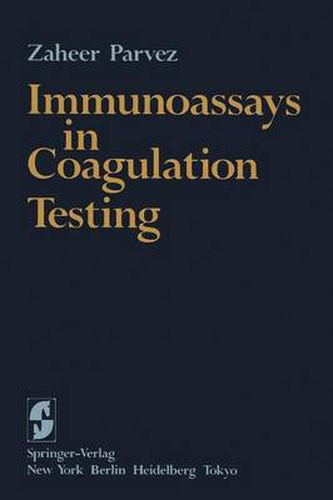Readings Newsletter
Become a Readings Member to make your shopping experience even easier.
Sign in or sign up for free!
You’re not far away from qualifying for FREE standard shipping within Australia
You’ve qualified for FREE standard shipping within Australia
The cart is loading…






This title is printed to order. This book may have been self-published. If so, we cannot guarantee the quality of the content. In the main most books will have gone through the editing process however some may not. We therefore suggest that you be aware of this before ordering this book. If in doubt check either the author or publisher’s details as we are unable to accept any returns unless they are faulty. Please contact us if you have any questions.
Rapid progress in analytical methods, within the past few decades, has led to the widespread applications of newer immunological and radioimmunoassay techniques to the diagnosis and treatment of hemorrhagic and thrombotic disorders. Major advances were made to meet the multiple challenges of improving precision, accuracy, and availability of various measurements. These advances have been paralleled by the discoveries of a close relationship between biological activities and the absolute concentration of proteins that were measured by immunological techniques. This, in turn, assured the significance and usefulness of immunological methods in the management of patients. Numerous variants of immunological tests now are available, which allow us to both determine with precision minute quantities of antigenic proteins in serum and other biological fluids and differentiate the native protein from its genetically altered or degraded forms. Methods also have been designed to immunologically evaluate some serine proteases that are in complex with proteolytic inhibitors. Due to rapid progress in this field, different laboratories unavoidably become experts in one or the other approach. In the welter of possible choices, the non-expert usually is left to follow either the most recent but as yet to be confirmed method or his own anecdotal experience. This manual not only brought together various methods in current use, but it also set certain standardized criteria for the assessment of various deficiencies and abnormalities in hemostasis.
$9.00 standard shipping within Australia
FREE standard shipping within Australia for orders over $100.00
Express & International shipping calculated at checkout
This title is printed to order. This book may have been self-published. If so, we cannot guarantee the quality of the content. In the main most books will have gone through the editing process however some may not. We therefore suggest that you be aware of this before ordering this book. If in doubt check either the author or publisher’s details as we are unable to accept any returns unless they are faulty. Please contact us if you have any questions.
Rapid progress in analytical methods, within the past few decades, has led to the widespread applications of newer immunological and radioimmunoassay techniques to the diagnosis and treatment of hemorrhagic and thrombotic disorders. Major advances were made to meet the multiple challenges of improving precision, accuracy, and availability of various measurements. These advances have been paralleled by the discoveries of a close relationship between biological activities and the absolute concentration of proteins that were measured by immunological techniques. This, in turn, assured the significance and usefulness of immunological methods in the management of patients. Numerous variants of immunological tests now are available, which allow us to both determine with precision minute quantities of antigenic proteins in serum and other biological fluids and differentiate the native protein from its genetically altered or degraded forms. Methods also have been designed to immunologically evaluate some serine proteases that are in complex with proteolytic inhibitors. Due to rapid progress in this field, different laboratories unavoidably become experts in one or the other approach. In the welter of possible choices, the non-expert usually is left to follow either the most recent but as yet to be confirmed method or his own anecdotal experience. This manual not only brought together various methods in current use, but it also set certain standardized criteria for the assessment of various deficiencies and abnormalities in hemostasis.